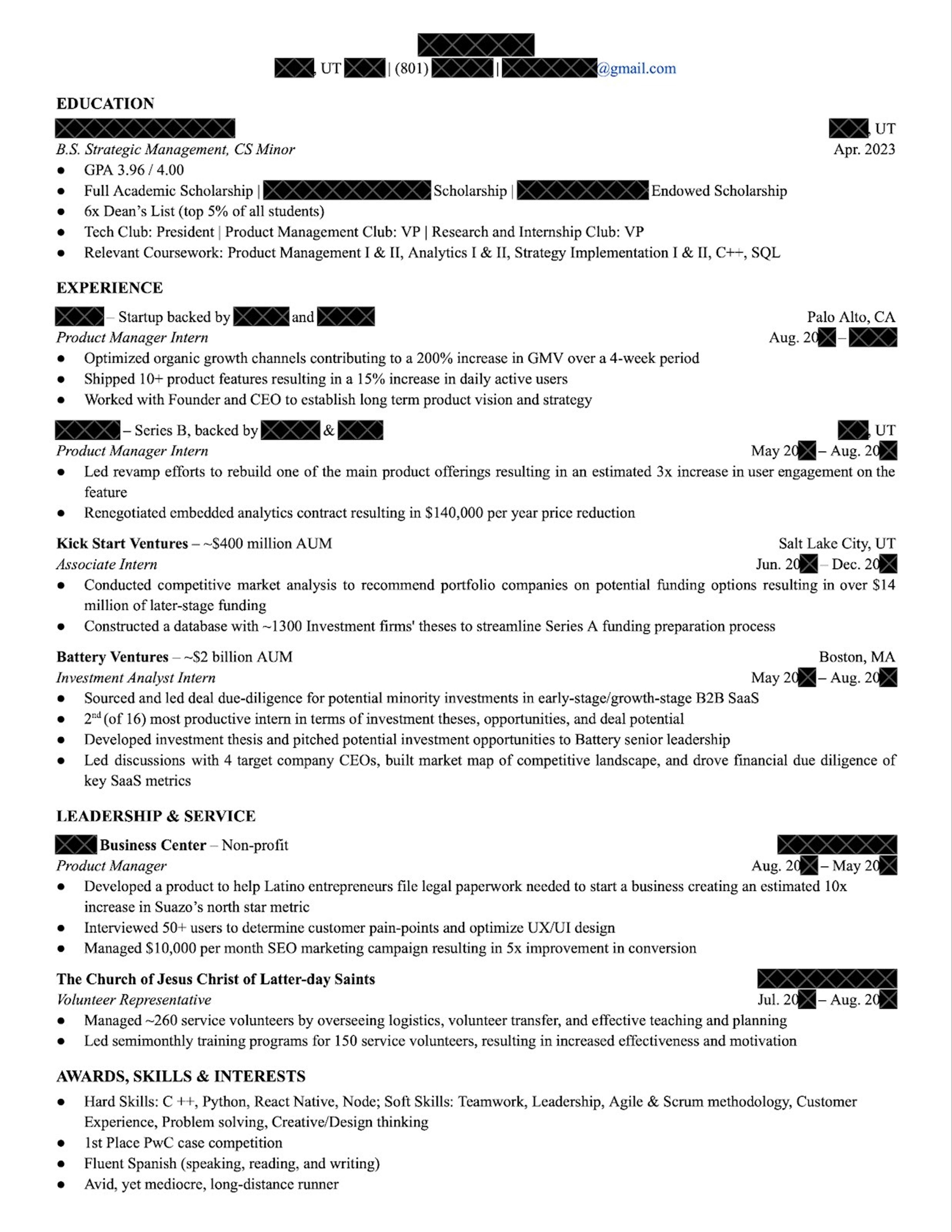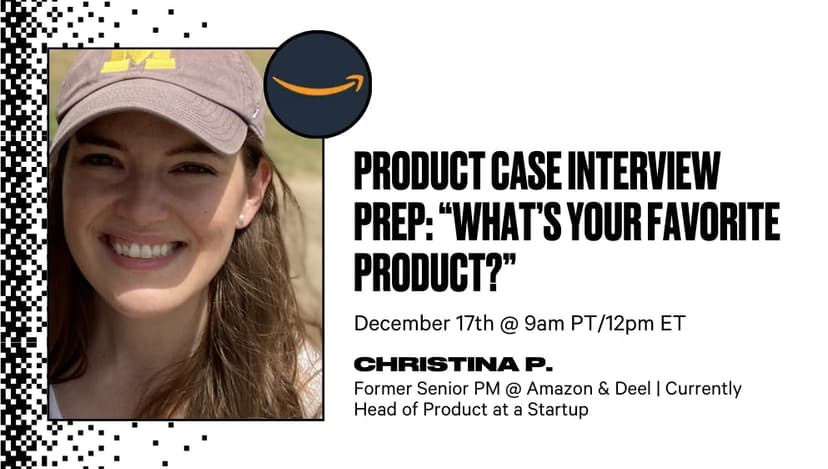Associate Product Manager (APM) Resume Guide — With Examples
Learn how to create a standout Associate Product Manager resume with expert tips and examples, showcasing your skills, experience, and achievements to land your next APM role.
Posted November 9, 2025

Join a free event
Learn from top coaches and industry experts in live, interactive sessions you can join for free.
Table of Contents
Breaking into product management starts with a great resume. Whether you’re applying to an Associate Product Manager (APM) program at a top tech company or targeting your first entry-level product role, your resume is your pitch: it needs to be data-driven, well-structured, and tailored to the job description.
This article will guide you through the process of creating a standout entry-level product manager resume. You'll learn what makes an effective APM resume, discover key skills to highlight, and get insider tips on how to make your application shine. We'll also provide examples and a handy template and example to help you get started. Whether you're a seasoned professional or just starting out, this guide will equip you with the tools to create a resume that opens doors in the exciting world of product management.
For an overview of top APM programs, read: Top 20 APM Programs
What Is an Associate Product Manager?
An Associate Product Manager is typically an entry-level product management role. APMs support more senior PMs in defining product strategy, shipping new features, conducting market research, and translating user feedback into roadmap decisions. Many companies run rotational APM programs designed to train future product leaders.
Read: What is Product Management?
Why Your Resume Matters for APM Roles
APM programs are highly competitive. Hiring managers often skim hundreds of applications for a few interview slots. Your resume needs to:
- Pass through applicant tracking systems (ATS)
- Clearly show technical and soft skills
- Quantify your data-driven decision-making
- Align with the job description and key business goals
Even if you’re early in your career or pivoting from another field, your resume should show a proven track record of delivering results, leading projects, or solving customer problems.
Associate Product Manager – Responsibilities
An Associate Product Manager (APM) plays a crucial role in driving product development and collaborating across teams to bring new features and products to life. APMs are often part of rotational programs designed to fast-track their growth as future product leaders.
In this section, we outline the key responsibilities that APMs typically take on, ranging from product strategy and customer research to cross-functional collaboration and data analysis. These responsibilities provide APMs with hands-on experience in the entire product lifecycle management while developing essential skills in problem-solving, communication, and decision-making.
| Responsibility Area | What It Looks Like in Practice | Tactical Skills & Tools | What Hiring Managers Want to See |
|---|---|---|---|
| Product Strategy & Vision | Collaborate with senior PMs to define product goals, OKRs, and long-term direction. Conduct competitive and customer analysis to support strategic decisions. | Market research, SWOT, Porter’s Five Forces, vision decks, product roadmaps | Ability to think long-term, align product with company goals, and translate market data into actionable plans. |
| Product Development | Partner with engineering, design, and marketing teams to ship features from idea to launch. Own specs and backlog. | Jira, Asana, Confluence, Figma, user stories, PRDs, sprint planning | Ownership over features, writing clear requirements, ability to prioritize under pressure. |
| Cross-functional Collaboration | Act as the bridge between engineering, marketing, sales, and support. Ensure everyone is aligned on deliverables. | Slack, standups, stakeholder updates, kickoff docs, retrospectives | Strong communication, facilitation, and the ability to work across multiple departments without silos. |
| Customer Research & Feedback | Conduct interviews, surveys, usability testing, and dig through support tickets to understand customer pain points. | User research, Typeform, Maze, Hotjar, NPS analysis, voice-of-customer tools | Empathy for users, a clear connection between user insights and product changes. |
| Data Analysis & Metrics | Track key performance indicators like user retention, activation, and engagement. Use data to inform decisions. | SQL, Tableau, Amplitude, Google Analytics, A/B testing platforms | Comfort with data-driven decision making and an ability to translate numbers into action. |
| Product Launches | Help coordinate launches with digital marketing, CX, and sales. Create enablement docs and support the go-to-market strategy. | Launch checklists, Google Docs, Slack workflows, marketing briefs | Execution-focused mindset, attention to detail, and the ability to drive excitement and alignment. |
| Problem-Solving & Tradeoffs | Identify blockers, propose solutions, and make tradeoffs between scope, timeline, and resources. | Prioritization frameworks (RICE, MoSCoW), impact vs effort, team retros | Clear decision-making process and comfort navigating ambiguity. |
| Stakeholder Management | Present product updates to leadership. Facilitate alignment across cross-functional teams. | Memos, slide decks, roadmap reviews, 1:1s with execs | Executive presence, persuasive storytelling, and transparency with both wins and blockers. |
| Continuous Learning | Stay up to date with industry trends, attend PM events, read PM books, and seek feedback. | Reforge, Lenny’s Newsletter, PM podcasts, product teardown writing | Growth mindset, curiosity, and initiative — top companies look for lifelong learners. |
| Project Management | Keep teams accountable to timelines and scope. Create clear plans and ensure teams are unblocked. | Gantt charts, sprint boards, retrospectives, RACI models | Strong project management instincts, planning skills, and ability to deliver consistently. |
As an APM, you'll have the opportunity to learn and grow in a supportive environment. Companies often hire APMs to nurture talent early on, allowing you to understand their vision and goals while developing your skills. This role provides an excellent foundation for a career in product management, offering guidance and mentorship as you gain hands-on experience in the field.
What Is an Associate Product Manager Resume?
An Associate Product Manager resume is more than a list of past roles; it's your strongest tool for breaking into product management. Whether you're coming from an internship, a bootcamp, or a non-PM background, your resume needs to clearly showcase your problem-solving mindset, user focus, and ability to collaborate across cross-functional teams.
For many applicants, especially those applying straight from school or pivoting into tech, this might look more like a product manager intern resume or project-based portfolio. And that’s okay. What matters most is how you present your impact, adaptability, and product thinking.
A strong APM resume should highlight:
- Experience with data analysis, project management, and user research
- Contributions to relevant projects, even if they weren’t full-time roles (e.g., internships, side projects, hackathons, or course capstones)
- Results that tie directly to user outcomes, such as improved customer satisfaction, increased adoption, or faster onboarding
- Evidence that you understand the product lifecycle, even if you haven’t owned one end-to-end
Coach Tip: If you don’t have formal PM experience yet, focus on the “why” and “impact” of the work you’ve done. Did your relevant project help users solve a problem? Did your internship contribute to or influence roadmap decisions? That’s what hiring managers care about.
Read: The Ultimate Guide to Product Manager Portfolios (With Examples)
Sections & Information to Include on Your APM Resume
Header
Include your name, phone number, email address, address or city/state, and LinkedIn profile link.
Education
Highlight the institutions you attended, the degree pursued/obtained, and any highlights or important experiences from them. (Note: When you’re more senior in your career, “Experience” should come before “Education” – if you’ve had enough roles, you could still put “Experience” first on your APM resume.)
Example Descriptions:
- Graduated with a 3.8 GPA while completing relevant coursework in product management, data analysis, and user experience design, successfully completed a business administration concentration.
- Led a team project in a Product Management course that resulted in a 15% improvement in user retention for a simulated app based on A/B testing results.
- Received the Dean’s List award (top 5% of students) for 6 consecutive semesters while balancing a full-time course load and a part-time internship.
- Achieved a top 10% ranking in the class for coursework in Agile methodologies, data-driven decision making, and project management.
- Graduated with a minor in Computer Science, with projects focused on building wireframes and developing user-centered features for mock products.
Experience
List your most recent and relevant roles first, following a reverse-chronological format. Include two to five bullet points for each role, focusing on noteworthy achievements that match the job requirements. Quantify wherever you can to show the impact that you had on the organization.
Examples:
- Increased user engagement by 35% in six months by launching a personalized recommendation engine for the mobile app.
- Drove a 50% reduction in customer churn by implementing new onboarding features and improving UX design.
- Led a cross-functional team of 10 engineers and designers to launch a new product, resulting in $2M in additional revenue within the first quarter.
- Improved product delivery efficiency by 20% through the introduction of Agile methodologies and streamlining communication across departments.
- Grew monthly active users by 45% by optimizing user retention strategies and rolling out quarterly targeted feature updates.
- Managed end-to-end development of a new feature that increased customer satisfaction scores by 15% within three months of launch.
- Generated a 25% increase in average order value by introducing A/B tested pricing strategies and implementing dynamic product bundling.
- Reduced product launch cycle time by 30% through process optimization and closer alignment between product and engineering teams.
- Boosted app store rating from 3.8 to 4.5 stars by introducing customer feedback loops and improving customer support integration.
- Achieved a 150% increase in B2B client acquisition by developing and launching a high-demand feature tailored to solve key enterprise customer needs.
- Proven track record of driving user growth, increasing daily active users by 20% in three months through the successful implementation of new feature sets and A/B testing.
Others
Skills
- Showcase both technical and soft skills, which may include:
- Product roadmap development
- Scrum and Agile methodologies
- Data analysis and visualization
- User experience (UX) design
- Communication and presentation skills
- Problem-solving and critical thinking
- Market trends and opportunities, and other market research
- Collaboration with cross-functional teams
Interests
- Who are you as a person? A line or two about your interests is a great way to show some humanness, and it gives the hiring manager something to talk about in the interviews.
- Examples:
- Learning traditional Japanese pottery techniques, focusing on Raku and Kintsugi styles.
- Documenting street photography in urban areas, with a focus on architecture and human interaction.
- Collector and curator of rare vinyl records from 1970s jazz musicians.
- Training for my third ultra-marathon.
Certifications
- Include any relevant industry certificates to demonstrate your technical knowledge or people skills. These are not weighed as heavily as employment experiences or projects, but can be a good addition.
Note: When crafting your entry-level product manager resume, quantification and showing impact are one of the most critical things to do. For example, include the percentage increase in product adoption due to initiatives you led or the number of features you've successfully managed. This approach helps to showcase your concrete contributions and achievements in previous roles.
Associate Product Manager Resume – Example
To help you craft an impressive associate product manager resume, let's look at a real-world example that showcases effective strategies for standing out among the competition. This example highlights best practices for presenting your relevant skills and achievements in product management, and is a real resume that an APM used to recruit and receive offers at several top tech companies.

This APM resume stands out due to its balance of quantifiable achievements, technical skills, and leadership experience, all of which are critical for a product management role. The candidate showcases their ability to drive tangible results, such as increasing GMV by 200% and leading key projects, which highlights their impact in previous roles. The experience spans both startups and established firms, demonstrating versatility and adaptability.
Additionally, the resume effectively communicates leadership and collaboration skills, both of which are essential in APM positions where cross-functional teamwork is key. Strong academic credentials and relevant coursework in product management, analytics, and strategy further strengthen the profile, ensuring a solid foundation of knowledge. The inclusion of technical and soft skills, combined with evidence of a strong work ethic and leadership outside of work, makes this a compelling product manager resume that demonstrates readiness to take on the challenges of product management.
Top Tips for Your Associate Product Manager Resume
Tip #1 – Include a mix of hard and soft skills
In crafting an effective Associate Product Manager resume, focus on a concise skills section that highlights a blend of technical expertise, collaborative abilities, and leadership potential. Include a mix of hard and soft skills, along with side projects that showcase your initiative and passion. This not only positions you as a well-rounded candidate but will also help you to stand out from the competition.
Hard Skills - Examples:
- Product Management Software Development: Highlight your proficiency in tools like JIRA, Trello, or Asana.
- Data Analysis: Showcase your relevant experience with Excel, SQL, and other data analysis tools.
- User Experience (UX) Design: Emphasize your understanding of UX principles and user-centered design processes that have led to customer satisfaction and adoption/retention.
- Market Research Techniques: Demonstrate your ability to conduct thorough market analysis and competitive research.
- Market Analysis: Highlight your ability to identify potential market trends and opportunities.
- Agile Methodologies: Highlight your familiarity with Agile development practices.
- A/B Testing: Showcase your experience with A/B testing tools and methodologies.
- Wireframing and Prototyping: Include your skills in tools like Figma, Sketch, or Adobe XD.
- Analytical Skills: Mention your proficiency in platforms such as Google Analytics or Adobe Analytics.
- Technical Writing: Highlight your ability to create clear and concise technical documentation.
- Product Roadmap Development: Showcase your experience in creating and managing product roadmaps.
Soft Skills - Examples:
- Communication: Emphasize your strong verbal and written communication abilities.
- Problem-Solving: Highlight your aptitude for finding creative solutions to complex challenges.
- Team Collaboration: Showcase your ability to work effectively with cross-functional engineering and design teams, etc.
- Adaptability: Demonstrate your flexibility in a fast-paced, dynamic environment.
- Critical Thinking: Highlight your analytical and strategic thinking capabilities.
- Time Management: Showcase your ability to prioritize tasks and manage multiple projects.
- Empathy: Emphasize your customer-centric mindset and ability to understand user needs.
- Creativity: Highlight your innovative approach to product development.
- Decision Making: Showcase your ability to make data-driven decisions.
- Leadership: Demonstrate your potential to lead and inspire teams.
Tip #2 – Use action verbs to show impact
Using action verbs is crucial in making your resume more engaging and impactful. Instead of simply listing responsibilities, action verbs emphasize the results and contributions you made in each role. For example, verbs like "led," "launched," "optimized," or "drove" give a sense of initiative and achievement. These words help convey that you actively contributed to the success of your projects rather than passively completing tasks. This approach not only demonstrates your problem-solving skills and leadership potential but also aligns with what employers look for in an APM, someone who takes ownership and drives results. By using action verbs, you turn your resume into a compelling narrative that showcases the value you bring to the team.
Examples:
- Spearheaded the launch of a new feature, boosting customer engagement by 25% within the first month.
- Revamped the product development process, cutting release cycles by 20% while maintaining high quality standards.
- Engineered a targeted onboarding experience that drove a 15% increase in user retention.
Tip #3 – Quantify, quantify, quantify
When it comes to writing a powerful Associate Product Manager resume, numbers speak louder than words. Quantifying your achievements provides tangible evidence of your impact and helps potential employers understand the scale and significance of your work.
Instead of saying you “helped improve user engagement,” be specific: “analyzed user behavior data to increase user engagement by 30% over six months, maintaining a 95% customer satisfaction score.”
By using metrics such as percentages, dollar amounts, or time saved, you provide context to your achievements and make them more memorable. Whether it's boosting revenue, reducing costs, or shipping product features that drive engagement, quantifying your contributions shows that you understand the business side of product management and can deliver measurable results—exactly what hiring managers are looking for in an APM candidate.
Examples:
- Increased user engagement by 30% over six months by analyzing customer feedback and implementing UX improvements.
- Drove a 20% increase in annual revenue by launching a new pricing model, resulting in an additional $500K in revenue within the first quarter.
- Reduced customer onboarding time by 40%, cutting average setup duration from 10 days to 6 days, and improving overall customer satisfaction by 12%.
Tip #4 – Match keywords and skills from the job description
Tailoring your resume to match the keywords and skills in the job description is a crucial step to ensure you make it past applicant tracking systems (ATS) and catch the attention of hiring managers. Carefully review the job posting and identify key phrases or requirements—such as "product roadmap," “market research”, "cross-functional collaboration," or "data analysis"—then incorporate these terms naturally into your resume. Highlighting the exact skills the employer is seeking demonstrates that you’re a great fit for the role and that you understand the specific needs of the position. This also shows attention to detail, which is an essential skill for an APM. Whether it’s technical skills, methodologies like Agile or Scrum, or experience with certain tools, aligning your resume with the job description will increase your chances of moving forward in the hiring process.
Tip #5 – Highlight relevant internships or side projects
For candidates early in their careers, internships and side projects can be as important as full-time experience. Include any relevant internships, freelance work, or personal projects that demonstrate your ability to manage products, work cross-functionally, excel at project management, or solve real-world problems. Highlight what you learned, the skills you applied, and the impact you made. This can help illustrate your initiative and passion for product management, even if you don't have years of experience.
Examples:
- Managed a side project to build a personal finance app from concept to launch, resulting in 500 downloads and a 4.8-star rating on the App Store within the first month.
- Led a cross-functional team of interns during a product management internship, delivering a prototype that increased user engagement by 15% in user testing.
- Developed a market research project for a local startup as part of a class, which identified a $200K untapped revenue opportunity and led to the introduction of a new product line.
Tip #6 – Focus on user-centered outcomes
Employers want to see that you understand how product decisions impact the user experience. In your resume, emphasize how your actions positively affected users, such as improving the user interface, increasing user satisfaction, or boosting engagement metrics. Showing that you have a customer-first mindset is a strong way to stand out in product management roles, where understanding user needs is paramount.
Examples:
- Improved user satisfaction by 18% by redesigning the onboarding flow to reduce friction and enhance first-time user experience.
- Enhanced mobile app usability by implementing user feedback, resulting in a 25% increase in daily active users and a 15% boost in customer retention.
- Developed a new feature based on user feedback, reducing support tickets by 30% and increasing the Net Promoter Score (NPS) by 10 points.
Tip #7 – Show progression and growth
Demonstrating a clear trajectory of growth in your previous roles signals that you are not only capable but also continuously improving. Even if you are early in your career, emphasize how you've taken on greater responsibilities over time, such as moving from an intern to a leadership role in a project, or how you managed more complex tasks as you progressed. This shows that you have the ambition and potential to grow in an APM role.
Examples:
- Started as a team member in a product-focused class project, later promoted to project lead, overseeing the development of a prototype that received top marks for innovation.
- Progressed from a research assistant to leading a small team of peers in a market research project, resulting in a detailed report that influenced the direction of a university startup.
- Began as a summer intern conducting competitive analysis and was later given responsibility for presenting findings to senior management, leading to the implementation of key recommendations.
Associate Product Manager Resume Template
Keep your resume to one page unless you have over a decade of applicable work experience. Always submit your resume as a PDF file to maintain its layout, unless otherwise specified.
[template]
Visit Leland’s Product Management page to access all the free online resources about product management. Get product management interview tips, see how to get into relevant programs, learn how to get into product management, and more.
The Bottom Line
Crafting a powerful associate product manager resume is key to landing your dream job in the tech industry. By highlighting your skills in data and market analysis, project management, and user research, you can show potential employers that you have what it takes to excel in this role. Remember to quantify your achievements and tailor your resume to each specific job opening to increase your chances of success.
To stand out in this competitive field, it's important that you continue on learning and grow your skills. Stay up-to-date with industry trends, network with other professionals, and seek out opportunities to gain hands-on experience. With dedication and the right approach, you'll be well on your way to a rewarding career as an Associate Product Manager.
Work With a Product Management Coach to Land Your First APM Role
Get one-on-one support from a product management coach to begin your career ASAP. From resume reviews to interview prep, our coaches have helped candidates break into APM programs at Google, Meta, Amazon, and more. Also, check out our product management bootcamps and free events for more helpful strategies!
Read next:
- The Product Execution Interview: Ultimate Guide (With Common Questions)
- The 50 Most Common Product Manager Interview Questions (With Sample Answers)
- Product Manager Resources: Books, Courses, and Communities for PMs
- Finance Product Manager Career Guide: Skills, Paths, and Interview Tips
- Product Marketing Manager Resume Guide [With Example & Template] (2025)
- Datadog Product Manager Interview: Process, Questions, & Tips (2025)
- The 10 Best Product Manager Interview Questions to Ask (And How to Answer Them)
FAQs
What is an Associate Product Manager?
- An Associate Product Manager (APM) supports product development by helping with research, planning, and coordination under the guidance of more senior product managers.
Is an Associate Product Manager an entry-level job?
- Yes, it’s typically considered an entry-level role for those starting a career in product management.
Is an Associate Product Manager a hard job?
- It can be challenging, as it requires strong communication, problem-solving, and organization skills, but it’s also a good learning role for new professionals.
Is an Associate Product Manager lower than a Product Manager?
- Yes, an APM usually reports to a Product Manager and has less responsibility for final decisions.
Browse hundreds of expert coaches
Leland coaches have helped thousands of people achieve their goals. A dedicated mentor can make all the difference.


























